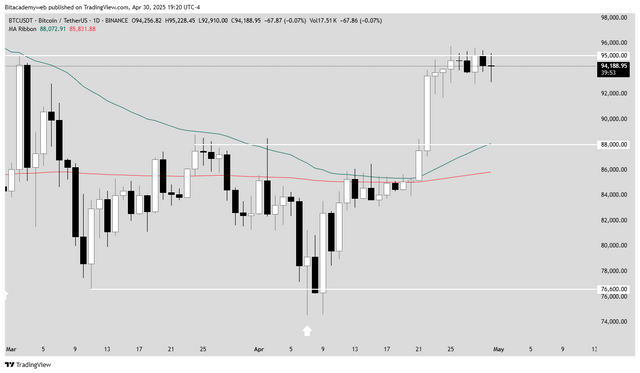The world's leading cryptocurrency navigates uncertainty after a disappointing jobs report and mixed US inflation signals, testing the crucial $95,000 resistance. What does the future hold?
The Bitcoin price experienced a day of indecision and mild volatility, trading around $94,188 at press time, with a slight daily loss of 0.07%. The leading cryptocurrency fluctuated between a high of $95,228 and a low of $92,910, forming a doji candle that reflects market uncertainty. This price action comes amid a series of US economic data that provide conflicting signals about the health of the economy and future monetary policy.

Technically, Bitcoin retested the resistance zone at $95,000, but failed to break above it convincingly. / TradingView
Unemployment Surprisingly Lower: A Respite for the Fed or a Sign of Weakness?
The ADP employment report revealed the creation of just 62,000 new jobs, significantly lower than market expectations (115,000) and the previous figure of 147,000. This lowest figure since January 2021 suggests a significant slowdown in private sector hiring, which could intensify concerns about global economic growth and, initially, generate risk aversion in assets like Bitcoin. However, this weak labor force could also pressure the Federal Reserve (Fed) to consider a pause or a "pivot" in its restrictive monetary policy, a historically favorable outlook for risk assets as liquidity increases.
Inflation with Two Faces: Relief in Sight or Persistent Pressure?
The PCE inflation data painted a complex picture. The Core PCE Prices QoQ Flash rebounded to 3.5%, beating expectations of 3.3% and the previous reading of 2.6%, indicating a persistence of underlying inflation. However, monthly figures showed significant moderation, with the Core PCE Index MoM stalling at 0% (the lowest since April 2020) and the PCE Index MoM also at 0% (the lowest since May 2024). This dichotomy poses a dilemma for the Fed: should it prioritize combating higher quarterly inflation or acknowledge the monthly cooling? Bitcoin's reaction will depend on which scenario prevails in the market narrative. A sustained inflationary moderation could reduce expectations for aggressive rate hikes, boosting risk assets, while persistent inflation could maintain downward pressure.
Bitcoin Struggles at Key Resistance: Next Bullish Move or Correction?
Technically, Bitcoin retested the resistance zone at $95,000, but failed to break above it convincingly. Despite this, the price remains above the 50- and 200-period exponential moving averages, which is generally interpreted as a sign of bullish sentiment. However, the drop in trading volume during the test of the resistance suggests a lack of buying conviction, which could indicate that this price zone is being respected by sellers and could precede a correction.
Bitcoin is at a crossroads, caught between conflicting signals from US economic data and a key technical resistance. A weak labor market could pave the way for less aggressive monetary policy, which historically benefits risky assets. However, the persistence of quarterly inflation and the lack of buying conviction in the $95,000 zone create uncertainty. Bitcoin's next price movements will depend on how the market interprets this data and anticipates the Fed's actions. Volatility will continue to be the norm as investors seek clarity in this complex economic landscape.
Disclaimer: This analysis is for informational purposes only and does not constitute financial advice. Cryptocurrency trading is highly volatile and carries significant risks of capital loss. Please conduct your own research before making any investment decisions.
Upvoted! Thank you for supporting witness @jswit.
Downvoting a post can decrease pending rewards and make it less visible. Common reasons:
Submit